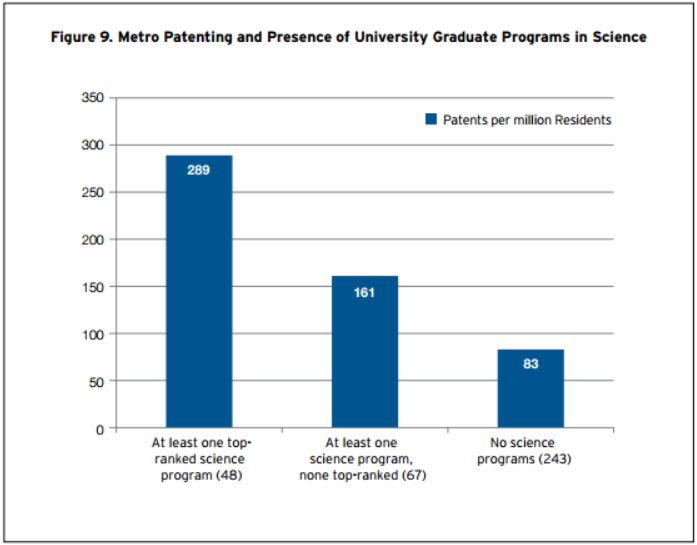Brookings Institute recently released a study in which it concluded that education is a strong driving force to high levels of innovation. Education and innovation are directly related to each other and the education-innovation relationship is also important to economic development.
The graph below compares innovation (patent rate) with the presence of graduate science programs.
Metropolitan areas that have at least one top-ranked university graduate science program obtain an average of 248% more patents than areas that have no graduate science programs. Data also shows that second tier research programs also contribute to high levels of innovation in metro areas. Areas that have at least one graduate science program (not top-ranked) obtain an average of 94% more patents than areas that have no graduate science program.
The top six metro areas with the most patents had at least 10 graduate level programs. The only city in the top ten that did not have a top-ranking graduate program was Detroit, MI.
Ranked by the presence of top science programs, the Boston metropolitan area dominates all others with 43 top science programs, thanks to Harvard and MIT. Yet, as Table 9 implies, California is the strongest state. It has 3 of the top 5 metro areas and 6 in the top 20.
Just a five percentage point increase in the share of workers with a STEM bachelor’s degree predicts an increase of 176 patents per million residents.
Education-Innovation
These are the top six metropolitan areas ranked by the number of patents granted:
- San Jose, CA
- San Francisco, CA
- New York, NY
- Los Angeles, CA
- Seattle, WA
- Boston, MA
Each of these areas has at least ten graduate level programs within STEM fields. Strong research universities enhance innovation beyond the presence of a technology sector. Even after taking into consideration population and share of employment in tech sectors, there is still a positive association with innovation and research universities.
The Brookings study also concludes that collaboration plays an important part in innovation. Places with a higher number of patents have more co-inventors per patent. This suggests more collaboration among researchers. Collaboration tends to be fostered by research universities.
The education-innovation relationship also works in reverse. Greater innovation in a community increases opportunities and demand for STEM educated workers. This tends to attract more funding and more students to STEM education programs. Companies also turn to research universities more often to participate in research projects, thereby fostering collaboration.
The moral of the story is clear: communities should invest in STEM education and STEM research universities. STEM education leads to greater innovation and greater innovation leads to economic development.
See also Innovation and the Economy, Rate of Innovation and Innovative City.



